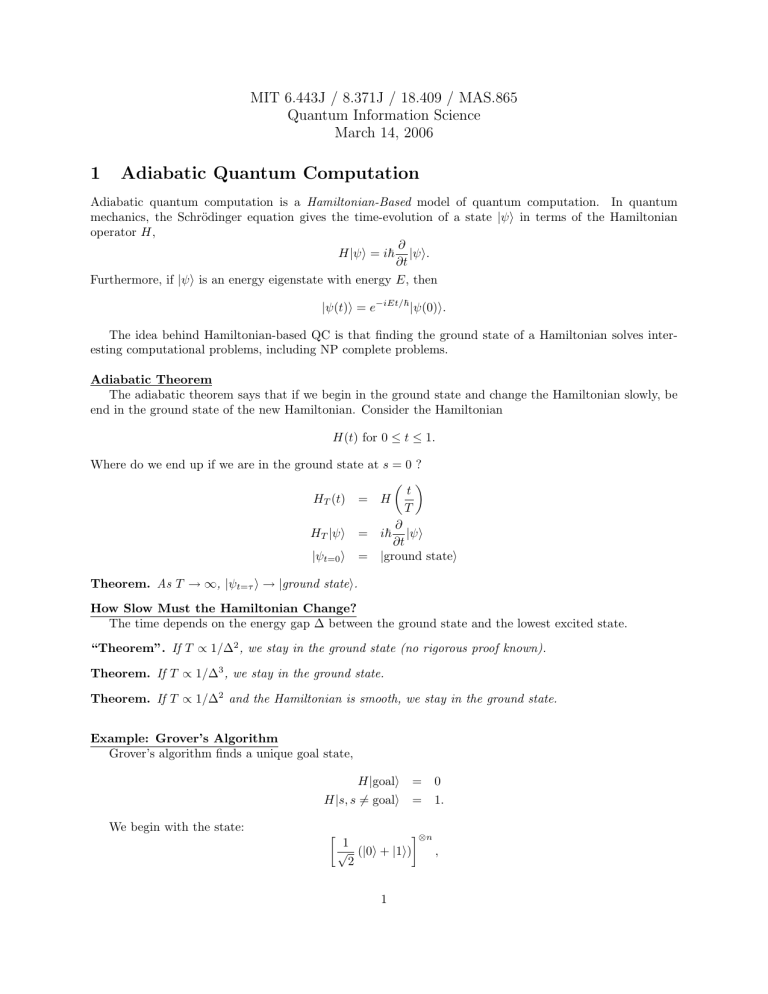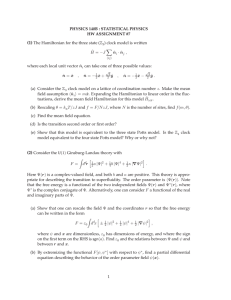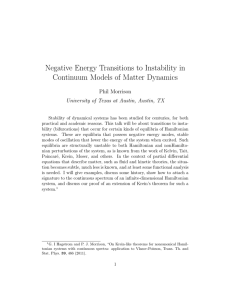1 Adiabatic Quantum Computation Quantum Information Science
advertisement

MIT 6.443J / 8.371J / 18.409 / MAS.865
Quantum Information Science
March 14, 2006
1
Adiabatic Quantum Computation
Adiabatic quantum computation is a Hamiltonian­Based model of quantum computation. In quantum
odinger equation gives the time­evolution of a state |ψ� in terms of the Hamiltonian
mechanics, the Schr¨
operator H,
∂
H |ψ� = i� |ψ�.
∂t
Furthermore, if |ψ� is an energy eigenstate with energy E, then
|ψ(t)� = e−iEt/� |ψ(0)�.
The idea behind Hamiltonian­based QC is that finding the ground state of a Hamiltonian solves inter­
esting computational problems, including NP complete problems.
Adiabatic Theorem
The adiabatic theorem says that if we begin in the ground state and change the Hamiltonian slowly, be
end in the ground state of the new Hamiltonian. Consider the Hamiltonian
H(t) for 0 ≤ t ≤ 1.
Where do we end up if we are in the ground state at s = 0 ?
� �
t
HT (t) = H
T
∂
HT |ψ� = i� |ψ�
∂t
|ψt=0 � = |ground state�
Theorem. As T → ∞, |ψt=τ � → |ground state�.
How Slow Must the Hamiltonian Change?
The time depends on the energy gap Δ between the ground state and the lowest excited state.
“Theorem”. If T ∝ 1/Δ2 , we stay in the ground state (no rigorous proof known).
Theorem. If T ∝ 1/Δ3 , we stay in the ground state.
Theorem. If T ∝ 1/Δ2 and the Hamiltonian is smooth, we stay in the ground state.
Example: Grover’s Algorithm
Grover’s algorithm finds a unique goal state,
H |goal� =
H |s, s �= goal� =
0
1.
We begin with the state:
�
�⊗n
1
√ (|0� + |1�)
,
2
1
which is the ground state of the Hamiltonian,
H = −σx(1) − σx(2) − . . . − σx(n) .
To find the gap, let |goal� = |00. . .0�. Note that the beginning state is symmetric: exchanging any two
qubits
� yields the same Hamiltonian. The space of symmetric states has dimensionality n√+ 1n and basis states:
1
|sk �, where the sum is over all bit strings with k 0s. The smallest gap is O(1/ 2 ) so the running
n
(k )
time is O(2n ). However, the gap over time looks like:
1st excited
ground
√
so by moving quickly when the gap is large, the time becomes O( 2n ).
Example: 3­SAT
3­SAT may be expressed as finding the ground state of a Hamiltonian. Given n variables with possible
values 0 and 1, and m clauses of the form xi ∨ x¯j ∨ xk (with any number of negations), can all clauses be
satisfied for some assignment of the variables? The Hamiltonian that answers this question is:
HC
H
(1 + Zi )(1 − Zj )(1 + Zk )
m
�
=
HC i
=
i=1
Note: the Hamiltonian is 3­local, which is desireable for physical implementations. What is the gap for
random instances of 3­SAT? Nobody knows.
2
Universality of Adiabatic QC
Theorem. Any quantum computation is equivalent, up to polynomial factors to 5­local adiabatic quantum
computation.
Steps:
1. Find a ground state that accomplishes the computation.
2. Show that the gap is large.
Encoding a Computation
Given a computation on s qubits with t steps, step i is given by:
Ui |ψi−1 � = |ψi �
|ψ0 � = |00. . .0�
2
The first bit encodes the answer. We want the probability of of the first bit being 1 to be close to 1 or close
to 0. There are two registers: computation and clock. The ground state that encodes the computation is
given by:
Wi
= Ui Ui−1 . . . U1
t
�
1
|g.s.� = √
Wk |0�comp ⊗ |k�clock
t + 1 k=0
Energy Penalties
We want to assign energy penalties for:
• having an incorrect initial state
• incorrect evolution
• bit 1 �= |0� in final state.
For the initial state we use a term picking out |1�k |0�clock :
E |1�k |0�clock �1|k �0|clock .
A similar term can be used for the final state.
When the clock goes from k − 1 to k, we need to apply Uk to the state. The penalty term to accomplish
this is:
I ⊗ |k��k| − Uk ⊗ |k��k − 1| − Uk† ⊗ |k − 1�|k� + I ⊗ |k − 1��k − 1|.
The Hamiltonian’s ground state thus encodes the entire evolution.
Modified 3­Local Hamiltonian
To make the Hamiltonian 3­local, we represent the clock in unary:
time k: |1�⊗k |0�⊗n−k .
Not all clock states are valid in this representation. We need to ensure there are no |01� sequences in the
clock states. We can now use 3­qubit clock terms in the penalty term for evolution.
Energy Gap
• Have: H |ψ� ≈ 0 if the computation answer is “yes”.
• Need: H |ψ� > 1/nk if the answer is “no”.
• Need: excited state H |ψ� > 1/nk if the answer is “yes”.
We perform a change of basis:
Wk |0�comp |k�clock → |0�comp |k�clock
accomplished by applying the unitary:
�
Wk† ⊗ |k��k|
k
to the original ground state. The effect on the Hamiltonian is:
Uk ⊗ |k��k − 1| → I ⊗ |k��k − 1|,
making the gap simple to calculate.
3
3
Fault Tolerance
Considering the final Hamiltonian, there may be an additional error term:
Hfinal
Hfinal + Herror
→
→
ground state |ψ�
|ψ̃�
We encode each qubit {|0�, |1�} to {|0L �, |1L �}:
|0�
→
|1�
→
1
(|0000� + i|0011� + i|1100� + |1111�)
2
1
(−|0101� + i|0110� + |1001� − |1010�) .
2
These states are in a subspace stabilized by:
XXXX
ZZZZ
XY ZI
so we assign an energy penatly for not lying in the logical subspace:
�
�
�
(k)
(k)
(k)
Hp =
−Ep g1 + g2 + g3
.
One­local errors take logical states outside the subspace. We want to put the Hamiltonian in terms of
XL , YL , ZL :
XL
YL
ZL
= Y IY I
= −IXXI
= ZZII
Note that this takes a k­local Hamiltonian to a 2k­local one. A 5 qubit code protects against 2­local noise
implemented with 3­local ooperators.
Condition. G = �g1 , g2 , . . . , gk � such that gi Gj = gj gi . When encoding 1 qubit, XL , YL , ZL are given by
cosets of G in G⊥ . If wt(G⊥ ) > t we want XL , YL , ZL with wt(t + 1) in each of 3 cosets G⊥ /G.
4









